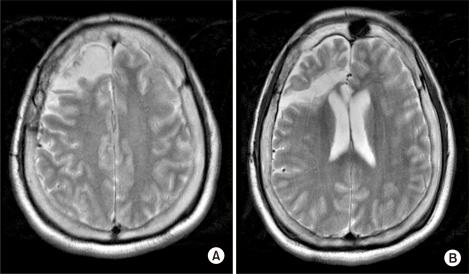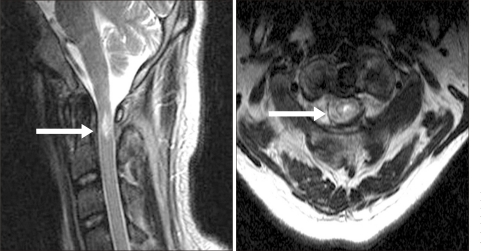Ann Rehabil Med.
2011 Aug;35(4):574-578. 10.5535/arm.2011.35.4.574.
A Case of Central Cord Syndrome Related Status Epilepticus: A Case Report
- Affiliations
-
- 1Department of Rehabilitation Medicine, Dongsan Medical Center, Keimyung University School of Medicine, Daegu 700-712, Korea. mykuckkuck@gmail.com
- 2Department of Radiology, Dongsan Medical Center, Keimyung University School of Medicine, Daegu 700-712, Korea.
- KMID: 1971726
- DOI: http://doi.org/10.5535/arm.2011.35.4.574
Abstract
- Central cord syndrome (CCS) is extremely rare as a direct consequence of generalized epileptic seizure. CCS is associated with hyperextension of the spinal cord and has characteristic radiologic findings including posterior ligamentous injury and prevertebral hyperintensity following magnetic resonance imaging (MRI). We experienced the case of a 25-year-old man who suffered CCS after status epilepticus. Cervical spinal MRI revealed high signal intensity at the C1 level but with no signal or structural changes in other sites. After rehabilitation management, the patient significantly improved on the ASIA (American Spinal Injury Association) motor scale and bladder function. We proposed that epilepsy related CCS may be caused by muscle contractions during generalized seizure, which can induce traction injury of the spinal cord or relative narrowing of spinal canal via transient herniated nucleus pulposus or transient subluxation of vertebra. We also suggest CCS without radiologic findings of trauma has good prognosis compared with other CCS.
Keyword
MeSH Terms
Figure
Reference
-
1. Kwan P, Brodie MJ. Early identification of refractory epilepsy. N Engl J Med. 2000; 342:314–319. PMID: 10660394.
Article2. Wirrell EC. Epilepsy-related injuries. Epilepsia. 2006; 47(Suppl 1):79–86. PMID: 17044832.
Article3. Roohi F, Fox A. Burst fracture of the first lumbar vertebra and conus-cauda syndrome complicating a single convulsive seizure: a challenge of diagnosis in the Emergency Department. J Emerg Med. 2006; 31:381–385. PMID: 17046478.
Article4. Kim YH, Kim HI, Ko DH, Woo YJ, Kim KW, Lee MC, Shin YI, Jang JH. Methodology for assessing and promoting the quality of life in patients with epilepsy. J Korean Acad Rehabil Med. 1996; 20:506–517.5. Souverein PC, Webb DJ, Petri H, Weil J, Van Staa TP, Egberts T. Incidence of fractures among epilepsy patients: a population-based retrospective cohort study in the General Practice Research Database. Epilepsia. 2005; 46:304–310. PMID: 15679512.
Article6. Kruitbosch JM, Schouten EJ, Tan IY, Veendrick-Meekes MJ, de Vocht JW. Cervical spinal cord injuries in patients with refractory epilepsy. Seizure. 2006; 15:633–636. PMID: 17070074.
Article7. Hohl JB, Lee JY, Horton JA, Rihn JA. A novel classification system for traumatic central cord syndrome: the central cord injury scale (CCIS). Spine. 2010; 35:E238–E243. PMID: 20228699.8. Nowak DD, Lee JK, Gelb DE, Poelstra KA, Ludwig SC. Central cord syndrome. J Am Acad Orthop Surg. 2009; 17:756–765. PMID: 19948700.
Article9. Tewari MK, Gifti DS, Singh P, Khosla VK, Mathuriya SN, Gupta SK, Pathak A. Diagnosis and prognostication of adult spinal cord injury without radio graphic abnormality using magnetic resonance imaging: analysis of 40 patients. Surg Neurol. 2005; 63:204–209. PMID: 15734500.10. Lim SH, Ko YJ, Shin JN, Kang SY, Moon SG, Kim JH. Functional recovery of patients with traumatic central cord syndrome. J Korean Acad Rehabil Med. 2002; 26:285–291.
- Full Text Links
- Actions
-
Cited
- CITED
-
- Close
- Share
- Similar articles
-
- A Case of Complex Partial Status Epilepticus
- Sevoflurane for the Management of Refractory Status Epilepticus : A case report
- Experience of Suspected Propofol Infusion Syndrome in a Status Epilepticus Patient: A case report
- Central Cord Syndrome after Standing of Head in a Child: A Case Report
- Fatal Propofol Infusion Syndrome Associated with Refractory Partial Status Epilepticus in a Patient with Cerebral Hyperperfusion Syndrome




